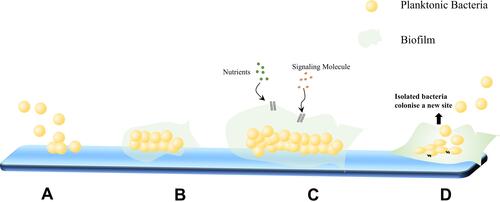Figures & data
Figure 1 Biofilm formation. (A) Adherence: Planktonic bacteria adhere to the surface of tracheal ducts. (B) Aggregation: Microorganisms undergo multilayer aggregation to form microcolonies. (C) Maturation: Channels form in the biofilm structure, allowing for the gradient transfer of nutrients and signaling molecules and facilitating the organized aggregation and differentiation of cells based on their metabolic state. (D) Dispersion: After maturation, the biofilm thickens and the interior forms an anaerobic environment, while the outer layer may begin to separate.

Table 1 Antibacterial Coated Tracheal Tubes: Progress
